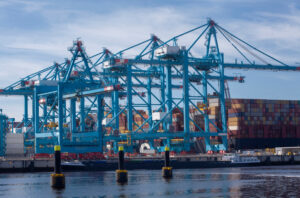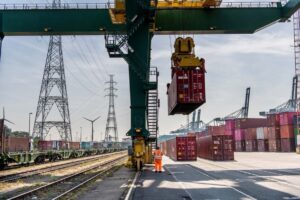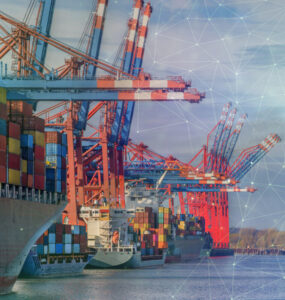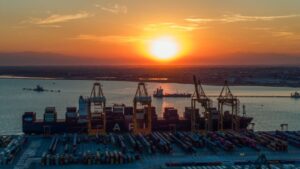Behind every successful ‘Smart Port’ in the world is a near-infinite amount of data that has been successfully transformed into actionable, profit-making solutions.
The benefits of the technological solutions that enable smart port transformation – the Internet of Things (IoT), Artificial Intelligence (AI) and Machine Learning (ML) among many others – are well documented.
As the Smart Digital Ports of the Future Conference (#SDP19) approaches, it is a good time to examine the real value of ‘Smart Data’ – what it is and how it is accelerating innovation and ports throughout the supply chain.
Essentially, it comes down to making the most of quantitative data – which can be measured and expressed using only numbers – and qualitative data, which brings tangible and direct benefits based on specific traits and characteristics.
This will be one of the topics up for discussion in ‘The Real Value of Smart Data’ session at SDP19, to be moderated by Leticia Astudillo, Principal Consultant, Drewry Associates.
The session will bring together Dr Francisco de los Santos, Chief Information & Innovation Officer, Algeciras Port Authority, Christian Blauert, CEO, Yilport Holdings, Emile Dorgeville, Sales Manager, Ports & Coastal, Miros AS, Kenneth Lim, Chief Technology Officer, MPA and Chuck Schneider, VP, Navis.

Here, the panelists will drill down into the benefits of ‘Smart Data’ and how different players in the industry have interests in different data streams.
First of all, in order to fully understand the value of ‘Smart Data’, we must first understand where it comes from and the subtle differences between ‘Smart Data’ and big data.
Points of Interest

The shipping industry generates approximately 120 million data points every day, a monumental figure made possible by the ever expanding supply chain and rapid acceleration of global trade.
According to a Deloitte poll, 81% of companies in the sector recognise the importance of big data and this is evident in the number of ports and terminals looking to utilize it through smart technologies.
The Port of Rotterdam, the CEO of which, Allard Catellein, will deliver the first keynote speech at SDP19, is looking to become the world’s ‘smartest’ port by fully utilizing big data and the respective technologies.
Port authorities are not the only stakeholders to see the major benefits of utilizing the mountains of data that sit within their systems.
In May 2019, terminal operator Yilport Holdings partnered with Navis, experts in terminal operating systems (TOS), to unlock the vast amounts of data.
In practice, this meant rolling out Navis’ Compass visual workflow management application to five of Yilport Holding’s container terminals where the N4 TOS is used.
The Compass application digitizes the workflow and standardizes the way terminals work, aiming to improve the quality of the planning, tracking and efficiency of the terminals.
Smart Data’s Big Beginnings

‘Big data’ is commonly defined as ‘large amounts of information produced very quickly by many different sources, such as people, machines or sensors’ and combines the two types of data: traditional and non-traditional.
As a previous exclusive insight – ‘Smart Ports of the Future: A Digital Tomorrow’ – explained, big data is one of the critical components of building a ‘Smart Port’, along with AI, blockchain, IoT and much more.
It allows companies to utilize massive amounts of information including, vitally, from non-traditional sources, including text, audio and video, to solve particular business problems.
For ports and terminals, leveraging big data, in short, means finding solutions for critical operational problems that traditional data cannot solve.
This is because traditional data is almost purely retrospective. For a shipper, this could mean transit times, revenue per TEU, freight rates, among much else – all analyzed with the objective of determining the profitability of a voyage.
Non-traditional data, however, is far broader and very often time-sensitive. If used correctly, it allows shippers, ports and freight forwarders to pre-empt hurdles, avoid logjams and unforeseen costs.
Weather, traffic delays and landside technological problems are all examples of these problems and the necessary data is generated by sensors, GPS devices and traffic management systems. If this data can be fully utilized, there is substantial potential for profit.
Making Data ‘Smart’

Transforming big data into ‘Smart Data’ involves mixing, updating and analyzing information from all the many sources and touchpoints to gain valuable, profit-making insights.
Simply put, ‘Smart Data’ is what you get once big data has been analyzed, filtered, contextualized in such a way that it can be used to pre-empt operational obstacles, which makes a highly valuable commodity for ports and terminals.
However, what are the real major advantages of doing so?
The answer is simple: greater productivity and lower costs, which in practice means being able to turn ships around faster and more efficient port maintenance.
Some of the major Asian ports, such as Shanghai, Singapore and Hong Kong, have adopted ‘Smart Data’ initiatives which have led to a steady increase in cargo traffic and enabled further growth.
In Europe, where ports are generally much smaller, there is arguably more investment in ‘Smart Data’ innovation.
The Port of Hamburg, Germany, for example, is seeking to utilize ‘Smart Data’ but wants to extend it to intelligent railway points through sensors and harnessing shore power from renewable energies to ensure the benefits are felt beyond the port.
The reach of ‘Smart Data’ can be felt and harnessed on the ocean-side as well. CMA CGM, the fourth largest container shipping line in the world, has recently partnered with ‘Smart Data’ experts Traxens to create what it calls ‘smart containers’.
This means the containers are fitted with sensors that communicate data, including location, condition etc, across the relevant supply chain stakeholders, which subsequently allows ports and freight forwarders to prepare for their arrival.
The Value of Being Smart

The more ports and supply chain stakeholders utilize ‘Smart Data’, the greater the benefits become. As the supply chain becomes more transparent, the possibilities are arguably endless.
Naturally, a deeper, more extensive answer to that question will be delivered at ‘The Real Value of Smart Data’ session at #SDP19.
Want to learn more? This topic will be discussed in further detail by industry-leading experts at the Smart Digital Ports of the Future 2019 conference, 4th – 6th November 2019. Register your interest in attending or book your place by clicking here.









